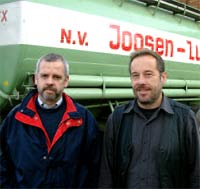Been There, Done That
Belgium's Joosen-Luyckx has a 4-year head start raising standard broilers without in-feed growth promoters and anticoccidials.
 Claeskens and Verdonck: 'There are no proposed standards that we haven't
implemented already.'
|
On January 1, when most European
broiler producers were
turning their calendars and
fretting over anticipated performance
losses following the new ban on antibiotic
growth promoters, veterinarian
Marc Claeskens and nutritionist Willy
Verdonck were toasting their success in
2005 and looking forward to another
good year for themselves and their
contract hatcheries and growers.
They could afford to be nonchalant
about the new antibiotic regulations
because their company, Joosen-Luyckx
of Turnhout, Belgium, hasn't used an
antibiotic growth promoter in their
standard broilers or specialty birds for
the last 4 years. For that matter, Joosen-
Luyckx hasn't used anticoccidials in
broiler feed, either.
"As far as I know, there are no other
standards or proposed standards that
we haven't implemented already,"
Verdonck says. "No growth promoters
or anticoccidials in the feed, no animal
protein, no animal fat, no genetically
modified organisms. This is the trend in
the poultry industry and, more importantly,
it's what our retailers are
demanding. They give us clear specifications
"feed ingredients, weight, the
number of birds per square meter, for
example "and we have to meet them."
Joosen- Luyckx contracts with four
local hatcheries and 80 growers to
place about 150,000 birds a week. Half
of these birds are standard broilers
raised to 1.8 to 2.5 kg (3.97 to 5.51 lbs).
The others birds are produced for specialty
markets, including 7,000 Le
Coucou de Malines, a traditional, indigenous,
pure line known throughout
Europe for its unique texture and flavor.
All birds are slaughtered and marketed
as whole chickens by Joosen-Luyckx's
sister company, Belki.
"We are the only company in
Belgium producing Le Coucou de
Malines," Claeskens says. "So while the
total number of birds from this line is
small in comparison to the rest of our
operation, Le Coucou is the most
important for us in terms of recognition
and reputation. Retailers associate our
products with quality."
Going drug-free
While Claeskens and Verdonck concede
that the relatively small size of
their poultry operation eased their transition
to drug-free production, their
experiences and ideas are of interest to
producers of all sizes "not just in
Europe, but anywhere poultry companies
need to change production practices
to meet new government regulations
or growing consumer demand for
birds raised without subtherapeutic
drugs in the feed.
"As a nutritionist, I'm very happy
about keeping drugs out of the mill,"
Verdonck says. "We raise five different
types of birds, all with different diets,
so that can mean 20 to 24 different
broiler feeds from start to finish. The
ionophores are particularly difficult at
the feed mill because they tend to stick
to metal, so you have to rinse and rinse
and rinse the whole system to make
sure no residues get into other feed.
But even then, there's always a risk that
traces will get into the wrong feed."
Adds Claeskens, "The authorities can
measure drug residues up to 2 parts per
billion and they have a zero tolerance
policy, so I prefer to keep drugs out of
the feed mill, too "not just out of the
withdrawal feed, but out the entire
facility."
Joosen-Luyckx also takes extra precautions
with its suppliers of feed ingredients.
For example, they've asked their
vitamin supplier to produce poultry
premixes on the same production line
as cat and dog premixes to eliminate
the risk of antibiotic contamination.
Switch to vaccination
In June 2002, looking to fill the void left
by in-feed anticoccidials, Joosen-
Luyckx began vaccinating its standard
broilers for coccidiosis with Paracox-5,
a live vaccine administered to day-old
birds in the hatchery. They had used the product successfully in Le Coucou
birds and their organic line, but
Verdonck admits to being nervous at
first about pulling ionophores from the
feed of standard broilers.
"To be honest, I was very afraid of
the standard broilers becoming infected
with coccidiosis after we stopped using
feed medications, because that's the
way we had always managed the disease
in our more intensively raised
birds," Verdonck says. "But the vaccine
has worked very well for us.
Coccidiosis has not been a problem,
and the birds' performance is as good
or better than it was when we used
medications."
Claeskens says vaccinating with
Paracox-5 has also eliminated the need
to rotate in-feed anticoccidials. "We
were seeing coccidiosis outbreaks as
the birds got older, and we suspected
the drugs were losing their effectiveness,"
he explains. "That's completely
gone now. With the vaccine, we don't
have to worry about coccidiosis."
Using a vaccine has also given the
company more marketing flexibility.
Like many producers in Europe,
Joosen-Luyckx markets broilers in
stages. While some birds are
raised to 2.3 to 2.5 kg (5.07
to 5.51 lbs), others are sold
at 1.8 kg (3.97 lbs) to meet
local demand for smaller
birds. Other times, Claeskens
says, retailers suddenly order
more birds to meet the needs
of a special promotion. That
means Joosen-Luyckx has to
sell more lightweight birds
than expected "an option
they wouldn't have if they
had to worry about a drug's
withdrawal time.
"There's a 10-day withdrawal
period on some anticoccidial
drugs," Claeskens
says. "It takes us about 33 to
36 days to get a bird to 1.8
kg. If you have a 10-day
withdrawal period, you have
to pull the drug at 23 days.
And if you do that, you will
almost certainly get coccidiosis
at 28 days and then you'll
have nothing but dead
chickens. With the vaccine,
we don't have to worry
about withdrawal times, and
we know it will protect against coccidiosis
for the full life of the bird. The
best part is we can market the birds any
time."
Treating enteritis
For Joosen-Luyckx, the biggest challenge
of not using antibiotic growth
promoters is the potential for a greater
incidence of necrotic enteritis. In drugfree
production, it also appears more in
the acute form rather than the chronic
form.
Claeskens says the key to managing
acute enteritis is to react quickly.
"The farmer has to be alert to the
fact that suddenly 10 dead birds in a
house of 20,000 broilers is very important,"
he says. "If he waits 2 days, he
might have 200, 400, 500 dead birds.
You need to get in there and treat right
away with an antibiotic in the water,
usually amoxicillin, lincomycin or
tylosin."
Claeskens says acute enteritis was
initially a problem in about 80% of their
houses following the removal of antibiotic
growth promoters from the feed.
Through more vigilant biosecurity and
changes to their nutrition program, he
and Verdonck have been able to cut
that incidence dramatically.
"I did a study comparing our number
of antibiotic treatments with other
integrators that were using antibiotics
and ionophores in the feed," he adds.
"The need for antibiotic treatments was
very similar, only 6% more, so I think
the change to drug-free production has
been worthwhile."
More emphasis on nutrition
Claeskens and Verdonck believe that
most enteric problems can be managed
effectively through nutrition and using
high-quality raw materials, particularly
in the starter ration, to stimulate good
intestinal health early in the bird's
development. This strategy can also
help to minimize or eliminate any
short-term performance setbacks
caused by the coccidiosis vaccine,
which introduces a controlled, balanced
dose of Eimeria organisms to
stimulate the bird's natural immune system
so it can fight coccidiosis without
drugs.
Verdonck says it's also important to
be consistent with feed ingredients in
drug-free birds. Making abrupt changes
in the diet can stress birds and compromise
intestinal health.
"For many years a nutritionist's job
was to optimize feed performance for
the least cost," he explains. "So when a
certain raw material became cheaper,
we would use it in the broiler diet at
high levels. The market would determine
what ingredients we used, and
we could change them quickly as the
prices went up and down.
"I think that's more difficult to do
that today because the antibiotic
growth promoters had kind of a regulating
effect," he continues. "If we went
from using a fast digestible starch to a
slow one, for example, it was easier
because the antibiotic provided a cushion
and helped to offset the stress
caused by changing the diet."
Don't push
Claeskens says producers need to
change the way they approach their
nutrition program and cautions against
pushing the birds too hard.
"Today you have to play more with
digestibility. Don't just think about
grams of growth per day," he adds. "If
you need a daily growth of 80 grams,
simply raising the amount of energy in
the diet isn't going to work in drug-free
birds as it works in medicated birds.
"What you lose in growth from not
using an antibiotic, you can make up
for with high-quality ingredients, better
digestibility and improved intestinal
health in the first 25 days of age."
Now that's a good IDEA
Joosen-Luyckx's approach to intestinal health mirrors many of the recommendations
presented at "New Paradigms in Poultry Nutrition and Management," a symposium
hosted by Schering-Plough Animal Health in Portugal last spring. |
Source: CocciForum Issue No.11, Schering-Plough Animal Health.







